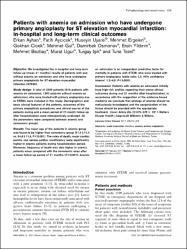| dc.contributor.author | Ayhan, Erkan | |
| dc.contributor.author | Ayçiçek, Fatih | |
| dc.contributor.author | Uyarel, Hüseyin | |
| dc.contributor.author | Ergelen, Mehmet | |
| dc.contributor.author | Çiçek, Gökhan | |
| dc.contributor.author | Gül, Mehmet | |
| dc.contributor.author | Osmonov, Damirbek | |
| dc.contributor.author | Bozbay, Mehmet | |
| dc.date.accessioned | 2019-10-16T11:34:35Z | |
| dc.date.available | 2019-10-16T11:34:35Z | |
| dc.date.issued | 2011 | en_US |
| dc.identifier.issn | 0954-6928 | |
| dc.identifier.uri | https://doi.org/ 10.1097/MCA.0b013e3283472ac5 | |
| dc.identifier.uri | https://hdl.handle.net/20.500.12462/7131 | |
| dc.description | Uyarel, Hüseyin (Balikesir Author) | en_US |
| dc.description.abstract | Objective We investigated the in-hospital and long-term follow-up (mean 21 months) results of patients with and without anemia on admission and who have undergone primary angioplasty for ST elevation myocardial infarction (STEMI). Study design A total of 2509 patients (616 patients with anemia on admission, 1893 patients without anemia on admission), who were treated with primary angioplasty due to STEMI, were included in this study. Demographics and basic clinical features of the patients, outcomes of the primary angioplasty procedures, and clinical course of the patients during and a mean period of 21-month follow-up after hospitalization were retrospectively evaluated. All the parameters were compared between anemic and nonanemic groups. Results The mean age of the patients in anemic group was found to be higher than nonanemic group (61.5 +/- 11.4 vs. 54.8 +/- 11.4, P < 0.001). The rates of death, major cardiac events, and severe cardiac insufficiency were significantly higher in anemic patients during hospitalization period. Moreover, frequency of death was also higher in anemic patients when compared with the nonanemic ones after a mean follow-up period of 21 months (P < 0.001). Anemia on admission is an independent predictive factor for mortality in patients with STEMI who were treated with primary angioplasty (odds ratio: 2.2; 95% confidence interval: 1.2-4.0; P < 0.009). Conclusion Patients with anemia on admission initially have high-risk profiles regarding their worse clinical outcomes during and 21 months after hospitalization. In accordance with the suggestion of the evidence-based medicine we conclude that etiology of anemia should be meticulously investigated and the oxygenization of the tissue should be provided with the appropriate treatment. Coron Artery Dis 22: 375-379 | en_US |
| dc.language.iso | eng | en_US |
| dc.publisher | Lippincott Williams & Wilkins | en_US |
| dc.relation.isversionof | 10.1097/MCA.0b013e3283472ac5 | en_US |
| dc.rights | info:eu-repo/semantics/openAccess | en_US |
| dc.subject | Acute Myocardial Infarction | en_US |
| dc.subject | Anemia | en_US |
| dc.subject | Primary Angioplasty | en_US |
| dc.title | Patients with anemia on admission who have undergone primary angioplasty for ST elevation myocardial infarction: in-hospital and long-term clinical outcomes | en_US |
| dc.type | article | en_US |
| dc.relation.journal | Coronary Artery Disease | en_US |
| dc.contributor.department | Tıp Fakültesi | en_US |
| dc.identifier.volume | 22 | en_US |
| dc.identifier.issue | 6 | en_US |
| dc.identifier.startpage | 375 | en_US |
| dc.identifier.endpage | 379 | en_US |
| dc.relation.publicationcategory | Makale - Uluslararası Hakemli Dergi - Kurum Öğretim Elemanı | en_US |


















